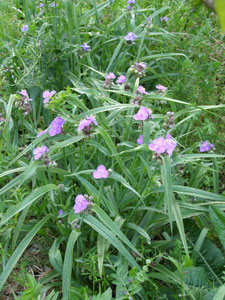‘Curiously lurking amongst the grassy leaves’
By Ken Moore
Flora columnist
Legendary English gardener and writer Vita Sackville-West described spiderwort as “… a plant I like very much, sometimes called the Trinity Flower, owing to its three petals of a rich violet, curiously lurking amongst the grassy leaves.â€
I love the notion of flowers “curiously lurking amongst the grassy leaves†because that’s exactly how I find them scattered about in my garden. I don’t remember planting one when I used to try being organized about gardening, but happily they freely self-seed, and I have them now scattered about the yard in both sunny and shady locations. Since they planted themselves I don’t have to be concerned about watering them.

A Carolina blue form of spiderwort lurking with the common blues at the N.C. Botanical Garden. Photo by Ken Moore
When they seem to have finished flowering and flop over during the heat of the summer, I simply cut the stems back and enjoy another flush of growth and flowering later in the season.
The one moving around my yard is most likely Tradescantia ohiensis, smooth spiderwort, with leaves having a somewhat whitish cast (glaucous) to them. The leaves immediately below the flower clusters are as wide as the stem leaves.
The name Trandescantia honors two notable English gardeners, the two John Tradescants, father and son. King Charles I sent the younger John Tradescant to Virginia in 1637 to gather all rarities of flowers, plants and shells. By that date the elder John Tradescant, the king’s gardener, was already growing many American plants in his London garden. Spiderworts were one of the earliest American plants transported back to England.
Spiderwort seedlings possess an endless palette of blue and violet flowers. No two are ever quite alike, and often one finds some really special colors. A rosy-red color form is “curiously lurking amongst the grassy leaves†at the edge of my porch steps this year.
For hardcore Tar Heel fans, there are some Carolina blue color forms of spiderworts “lurking†amongst all the others in a showy bed behind the Totten Center at the N.C. Botanical Garden. That “Carolina Blue spiderwort†(my name for it) has been in that bed for several years. I hope the garden staff will someday propagate and offer for sale Tradescantia ‘Tar Heel Blue.’
Native Americans ate young spiderwort plants as greens in the spring. However, the oozy, sticky sap of a broken spiderwort stem makes such an idea unappealing to me. Root teas were considered effective for stomach ailments and root poultices were considered an effective cancer cure. I particularly like the description of spiderwort as one of the ingredients in a medicine for kidney troubles, “… requiring an accompanying prayer.†A prayer is probably a wise necessity with any herbal remedy.
Lack of medical expertise guides me in keeping my spiderworts out of the medicine cabinet and encouraging them to “curiously lurk†anywhere they may choose in my landscape.
Email Ken Moore at flora@carrborocitizen.com. Find previous Ken Moore Citizen columns at The Annotated Flora (carrborocitizen.com/flora).




Comments are closed.